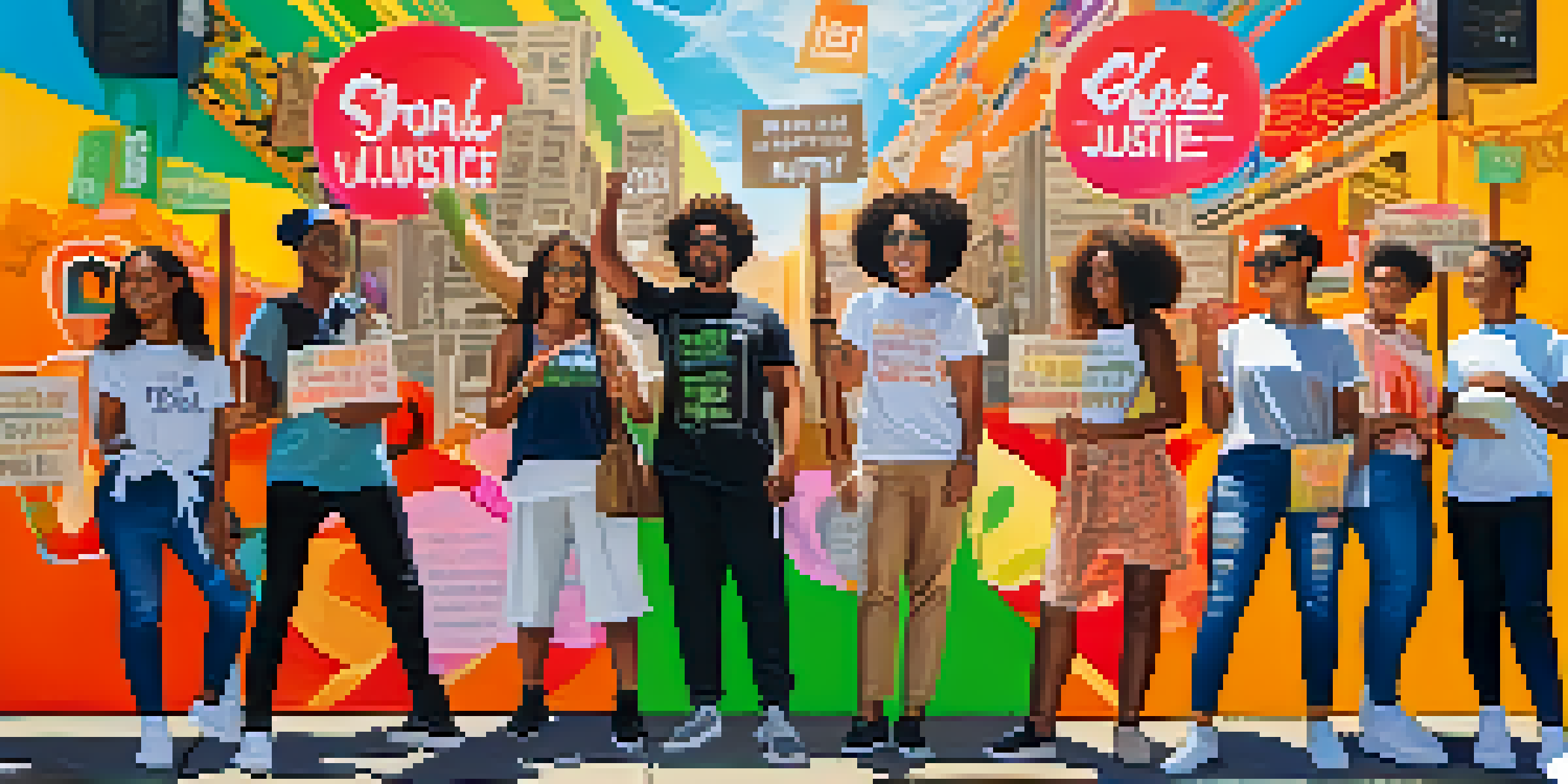Fashion and Digital Activism: Communities Sparking Change

The Intersection of Fashion and Activism in the Digital Age
Fashion has always been a reflection of society, and in today’s digital age, it's also a powerful tool for activism. Social media platforms amplify voices and movements that champion social justice, sustainability, and inclusivity. With influencers and brands taking a stand, fashion becomes a canvas for change, sparking conversations that resonate globally.
Fashion is the armor to survive the reality of everyday life.
Consider how campaigns like #BlackLivesMatter have inspired fashion brands to showcase their commitment to racial equality. Many have released collections that support the movement, donating proceeds to relevant causes. This synergy between fashion and activism highlights the profound impact that collective voices can have when amplified through digital channels.
As consumers increasingly seek out brands with a purpose, the fusion of fashion and activism isn’t just a trend; it’s a transformative movement. This engagement encourages brands to rethink their roles in society, making them more responsible and attuned to the needs of their communities.
Digital Platforms: The New Runway for Activism
Digital platforms like Instagram and TikTok have revolutionized how activism is presented and consumed. Fashion campaigns can go viral in a matter of hours, allowing messages of change to reach a vast audience quickly. This immediacy fosters a sense of urgency and connection among users, making them feel part of a larger movement.

For instance, the #SustainableFashion hashtag has garnered millions of posts, encouraging individuals to rethink their purchasing habits. By sharing personal stories, tips, and sustainable finds, users create a community dedicated to environmental consciousness. This grassroots activism empowers everyday people to make impactful changes, one outfit at a time.
Fashion as a Tool for Activism
In the digital age, fashion serves as a powerful platform for social and environmental movements, amplifying voices that advocate for change.
Furthermore, the visual nature of these platforms allows for creative expression that resonates with audiences. Through artful storytelling and engaging content, activists can capture attention and inspire action, proving that fashion is more than just clothing—it's a statement of values.
Communities United: The Power of Collective Action
When individuals unite under a shared cause, the impact can be monumental. Fashion communities, both online and offline, foster a sense of belonging and purpose. From local thrift swaps to global fashion shows advocating for climate change, these gatherings create spaces where activism thrives.
Clothing is a form of self-expression. There are hints about who you are in what you wear.
Take the example of Fashion Revolution Week, where communities worldwide come together to demand transparency in the fashion industry. Participants share their stories, engage in discussions, and call for accountability from brands. This collective voice not only raises awareness but also encourages consumers to make informed choices.
In essence, community-driven activism in fashion creates a ripple effect. As more individuals participate, the movement gains momentum, leading to significant changes in industry practices and consumer behavior. Together, these communities spark real change.
Fashion Brands Taking a Stand: Case Studies
Several fashion brands have recently stepped up to address social and environmental issues, using their platforms for advocacy. For instance, brands like Patagonia and Reformation have made sustainability a cornerstone of their missions, inspiring consumers to choose eco-friendly options. Their commitment not only attracts conscious consumers but also sets a standard for the industry.
Another notable example is Fenty Beauty, which has championed diversity and inclusivity in the beauty space. By offering a wide range of shades for all skin tones, the brand has sparked conversations about representation in fashion. This approach empowers individuals to embrace their identities, making a powerful statement about beauty standards.
The Role of Influencers in Change
Influencers significantly shape activism discussions by educating their audiences on sustainability and ethical practices in the fashion industry.
These case studies illustrate that activism can be woven into the very fabric of a brand’s identity. When brands align their values with those of their consumers, they not only drive change but also cultivate loyalty and trust, proving that fashion can indeed be a force for good.
The Role of Influencers in Fashion Activism
Influencers play a pivotal role in shaping conversations around fashion and activism. With their substantial followings, they can bring attention to important issues and influence consumer behavior. Many influencers use their platforms to educate their audience about sustainability, ethical sourcing, and social justice, creating a ripple effect of awareness.
For example, influencers like Aditi Mayer and Kristen Leo focus on sustainable fashion, sharing their journeys and offering practical tips. Their authentic storytelling resonates with followers, encouraging them to rethink their fashion choices and adopt more conscious consumption habits. This ability to connect on a personal level makes influencers powerful advocates for change.
Moreover, collaborations between brands and influencers can amplify messages of activism. When influencers partner with ethical brands, their endorsements can reach a wider audience, motivating fans to support causes that matter. In this way, influencers serve as vital channels for promoting social responsibility within the fashion industry.
Challenges Faced by Fashion Activists
While the intersection of fashion and activism is promising, it’s not without its challenges. One major hurdle is the potential for 'performative activism,' where brands or individuals engage in activism superficially without meaningful action. This can lead to skepticism among consumers who are increasingly discerning about authenticity.
Additionally, the fast-paced nature of digital media can sometimes overshadow the core messages of activism. In a world where trends come and go, maintaining a consistent, impactful narrative requires strategic planning and dedication. Activists must navigate the fine line between raising awareness and becoming just another fleeting trend.
Challenges in Fashion Activism
Despite its promise, fashion activism faces hurdles like performative actions and the need for genuine inclusivity to maintain authenticity.
Finally, there’s the challenge of inclusivity within the activism space itself. Ensuring that diverse voices are represented and heard is crucial for the movement’s success. As fashion activists continue to push for change, fostering an inclusive environment will remain key to driving authentic and lasting impact.
The Future of Fashion and Digital Activism
The future of fashion and digital activism looks bright, with the potential for even greater collaboration and impact. As technology evolves, new platforms will emerge, providing fresh avenues for activism. This ongoing innovation will allow communities to connect in novel ways, breaking down barriers and fostering inclusivity.
Moreover, as consumers continue to prioritize sustainability and social responsibility, brands will need to adapt and evolve. The demand for ethical practices is likely to grow, pushing the fashion industry towards greater accountability. This shift will create opportunities for new voices to emerge and champion change.

Ultimately, the fusion of fashion and digital activism is here to stay. As communities continue to spark change, the collective power of individuals will shape the future of the industry, ensuring that fashion not only reflects societal values but also drives progress for a better world.